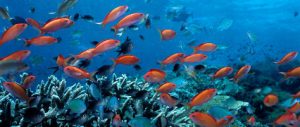In the late 1990s, I spent 18 months living in Lambir Hills National Park in Sarawak, in the Malaysian part of Borneo, where I was studying the rainforest for my PhD. Tropical rainforests are incredible places. They throb with life, and each day brings a new encounter with something spectacular.
The forest where I worked was small, at just under 70 square kilometres, and its wild animals had been hammered by hunting and habitat loss in the surrounding area. But the richness of its trees was second to none. In that forest you could mark out an area just 100 metres by 100 metres and enclose 800 different species of trees. By contrast, there are just 36 native tree species in the whole of the British Isles.
Sarawak’s indigenous people know their forests inside out – every tree has a name, a use and a value. There is the gaharu tree, whose wood produces a resin that smells so good that it can sell in the Middle East for thousands of dollars per kilogram. There are dozens of species of meranti, one of the most important timber trees of south-east Asia and dozens of species of wild fruit trees too.
There is the tapang tree, in which honey bees build their hives because it grows up to 80 metres tall and has smooth bark that the honey-loving sun bear cannot climb. Local Iban people are not deterred by this tree’s great height. They climb it and use smoke to scare off the bees while they harvest the honey.
The forest brings other, less immediate benefits to local communities too. Each night small bats that live in the forest take to the air and consume millions of insects, including commercially important crop pests and mosquitoes that transmit dengue fever. By day, bees, butterflies and beetles leave the forest and fly to farmers’ fields where they pollinate important food crops. Birds, fruit bats and monkeys disperse the seeds of many of the plants that local people have used for generations as traditional medicines; medicines that Western science is now showing to have measurable therapeutic effects. Forests also help to regulate the local climate, ensure clean water supplies and protect communities from flooding.
But Sarawak’s politicians – like those in all parts of the world – have not factored the value of these environmental goods and services into their policymaking. Until just a few decades ago, Sarawak was almost entirely cloaked in forests like the one I worked in. Today just 10% of the original forest cover remains – and that is mostly found in national parks, where local people are forbidden from using the resources within.
This month the scale of deforestation in Sarawak became clear. Malaysia’s biggest river – the Rajang, which runs for 563 kilometres from the heart of Borneo to the South China Sea – was blocked by thousands upon thousands of dead trees that had been washed into the river by heavy rain. The log-jam extended for 50 kilometres. One experienced sawmill manager estimated that there was 300,000 cubic metres of wood in the water. To put things in perspective, Sarawak sells that volume of plywood for about US$120 million (797 million yuan) every couple of months. This was no natural disaster. The trees were already cut. They had come from the highlands where the last remnants of loggable forest remain.
This is all bad news for Sarawak of course – its political elite have become millionaires through logging, while the majority of its people are not only still poor but also no longer have the resources their communities were sound custodians of for generations. But the benefits of tropical forests extend far beyond the borders of countries like Malaysia. Forests absorb and store vast quantities of carbon that would otherwise contribute to climate change. The richer, more diverse the forest is, the more carbon it stores.
Tropical forests are also the source of many of the medicines we take for granted. They have given us chemicals to treat or cure diabetes and malaria, heart conditions and skin diseases. More than two-thirds of all medicines with cancer-fighting properties come from rainforest plants. When you consider that Sarawak’s original forests had up to 800 tree species in a single hectare (100 metres by 100 metres) but have now been almost totally deforested, it becomes clear that human actions carry a huge cost that rarely gets counted.
And forests are not the only source of natural benefits under threat. The same applies to our coral reefs and dryland savannahs, our coastal mangroves forests and our deep oceans. The environment and human wellbeing are two sides of the same coin, and because of this biodiversity offers immense opportunities to reduce poverty and increase people’s resilience to climate change. But poor policies and legal frameworks governing how biodiversity is used and by whom mean that this potential is not being tapped.
To put a price-tag on what these things are worth, the Deutsche Bank analyst Pavan Sukhdev has spent the past two years running “The Economics of Ecosystems and Biodiversity” study. It concludes that the goods and services nature provides are worth between US$2 trillion (13.3 trillion yuan) and US$4.5 trillion (29.9 trillion yuan) annually. Sukhdev says the pollination service that insects and other animals provide alone is worth US$190 billion (1.3 trillion yuan) each year. But, because these benefits are not included in economic valuations and in policymaking, they tend to be overexploited. We expect finite resources to fuel infinite growth, and scientists warn that if we continue to bite the hand that feeds us it will slap us in the face.
That’s why this week’s big UN meeting in Japan is so important. Governments from around the world are gathering in Nagoya to make three key decisions that will determine whether current and future generations continue to benefit from nature’s riches.
On the table is a comprehensive ten-year strategy with 20 measurable targets. If approved and enacted it could revolutionise the way we manage and interact with the world about us, and bring immense social and economic benefits to people worldwide.
Also up for agreement in Nagoya are large flows of finance that will be needed to enact the strategy — for instance, to support developing countries that are asked to protect large areas of wilderness for the good of all of humanity. The costs will be high but the returns on the investment will be far greater because of the high value of the environmental goods and services that biodiversity provides us with.
The third piece of the puzzle is a new set of international rules that would provide transparent access to the world’s biological resources while ensuring that their countries of origin get a fair share of any benefits that arise from their use – such as when companies develop commercial medicines from plants or other life-forms.
This new “protocol” on access and benefit-sharing could create major incentives for countries to protect their forests and other natural capital while enabling businesses to use biological resources to develop useful new products in a sustainable way.
The meeting in Japan – known as COP10 – will bring together 193 parties to the UN Convention on Biological Diversity (CBD), an international law that was created at the Rio Earth Summit in 1992. Since then, there has been growing awareness of how important nature is to human health, livelihoods and national economies. But at the same time the state of the natural world has continued to decline steeply, as revealed in the Global Biodiversity Outlook 3 report which was released in May.
In 2002 governments agreed to reduce significantly the loss of biodiversity by 2010. But they failed, in large part because they did not address the underlying causes of biodiversity loss – such as a lack of awareness of the true value of biodiversity and a failure to include the true costs of biodiversity loss in policies and plans. With a new, more ambitious and better-designed strategy, governments now have another chance to create a global agreement to preserve and wisely use our planet’s living resources in ways that bring benefit to all.
Key to this will be better communication about biodiversity, conveying why it is important, what its decline means and what can be done about it. For this to happen, we need to focus on how the fate of biodiversity will affect our health, our wealth and our children’s future. We need to remember that people are part of the web of life, not apart from it. We need to focus on the benefits biodiversity can provide if we manage it well instead of telling doom-and-gloom stories of extinction and destruction.
To this end, the International Institute for Environment and Development (IIED) has teamed up with BirdLife International and Pavan Sukhdev to produce Banking on Biodiversity, a free pocket-sized guide that explains how nature’s riches can play a major role in poverty eradication. And in Nagoya on October 27, IIED, Internews and the International Union for Conservation of Nature will formally launch the Biodiversity Media Alliance, which aims to strengthen the quality and quantity of media coverage of this under-reported story, which has profound implications for livelihoods, health and businesses the world over – the silent decline in the planet’s biological resources.
Mike Shanahan is press officer at the International Institute for Environment and Development.
Homepage image from habitatnews



